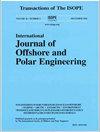Two-phase CFD Simulation of Breaking Waves Impacting a Coastal Vertical Wall with a Recurved Parapet
IF 0.6
4区 工程技术
Q4 ENGINEERING, CIVIL
International Journal of Offshore and Polar Engineering
Pub Date : 2023-06-01
DOI:10.17736/ijope.2023.sv03
引用次数: 2
Abstract
Breaking wave impacts on coastal protections are simulated using a multi-phase 3D CFD (Computational Fluid Dynamics) software, named neptune cfd, focusing on a particular lay-out composed of a plane slop-ing bottom and a vertical wall with a recurved parapet on top of it. The goal is to assess the capabilities and performances of the solver to simulate the propagation of regular waves over the variable bathymetry (in-cluding shoaling and nonlinear e ff ects), the depth-induced breaking process and the interaction of these breaking waves with the vertical wall. We simulate two experiments involving similar geometry of the seabed and vertical wall, performed at two di ff erent scales (1:8 for case A and 1:1 for case B), as described in Ravindar et al. (2021). After a descrip-tion of the CFD solver and its numerical methods, the model is applied to the simulation of the two cases involving extremely high impact pressure peaks at some places of the wall surface. Numerical results are compared with experimental measurements regarding both free surface elevation and pressure on the wall. In general, a good agreement of the simulations with the measurements is obtained for free surface elevation, including the breaking zone. The time history of pressure variations dur-ing wave impacts is correctly reproduced. Although the measured maximum impact pressure peaks exhibit some variability among successive wave impacts, the order of magnitude of these maximum peaks is well predicted for case A. For case B, however, the maximum impact pressures are somewhat underestimated by the current simulations, requiring further tests and improvements. This work is a contribution to the bench-mark “Comparative Study on Breaking Waves Interactions with Vertical Wall attached with Recurved Parapet in Small and Large Scale” set up for the ISOPE’2022 conference.波浪作用于带重复式女儿墙的海岸直墙的两相CFD模拟
使用名为neptune CFD的多相3D CFD(计算流体动力学)软件模拟了破浪对海岸保护的影响,重点关注由平面斜坡底部和顶部有弯曲女儿墙的垂直墙组成的特定布局。目标是评估求解器的能力和性能,以模拟规则波在可变水深(包括变浅和非线性效应)上的传播、深度引起的破碎过程以及这些破碎波与垂直壁的相互作用。如Ravindar等人所述,我们模拟了两个实验,涉及海床和垂直壁的相似几何形状,在两个不同的比例下进行(情况A为1:8,情况B为1:1)。(2021)。在描述了CFD求解器及其数值方法后,将该模型应用于两种情况的模拟,这两种情况涉及壁面某些位置的极高冲击压力峰值。将数值结果与自由表面高程和壁面压力的实验测量结果进行了比较。一般来说,对于自由表面高程(包括破碎区),模拟和测量结果基本一致。正确再现了波浪冲击期间压力变化的时间历程。尽管测得的最大冲击压力峰值在连续的波浪冲击中表现出一定的可变性,但对于情况A,这些最大峰值的数量级是可以很好地预测的。然而,对于情况B,当前的模拟在一定程度上低估了最大冲击压力,需要进一步的测试和改进。这项工作是对为ISOPE’2022会议设立的基准点“破碎波与附小尺度和大尺度递归女儿墙的垂直墙相互作用的比较研究”的贡献。
本文章由计算机程序翻译,如有差异,请以英文原文为准。
求助全文
约1分钟内获得全文
求助全文
来源期刊

International Journal of Offshore and Polar Engineering
ENGINEERING, CIVIL-ENGINEERING, OCEAN
CiteScore
2.00
自引率
0.00%
发文量
44
审稿时长
>12 weeks
期刊介绍:
The primary aim of the IJOPE is to serve engineers and researchers worldwide by disseminating technical information of permanent interest in the fields of offshore, ocean, polar energy/resources and materials engineering. The IJOPE is the principal periodical of The International Society of Offshore and Polar Engineers (ISOPE), which is very active in the dissemination of technical information and organization of symposia and conferences in these fields throughout the world.
Theoretical, experimental and engineering research papers are welcome. Brief reports of research results or outstanding engineering achievements of likely interest to readers will be published in the Technical Notes format.
 求助内容:
求助内容: 应助结果提醒方式:
应助结果提醒方式:


